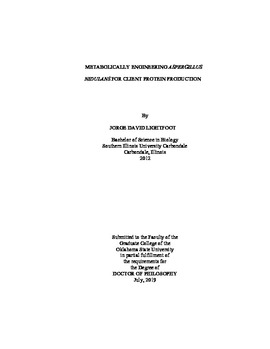| dc.contributor.advisor | Prade, Rolf | |
| dc.contributor.author | Lightfoot, Jorge David | |
| dc.date.accessioned | 2020-01-30T15:03:09Z | |
| dc.date.available | 2020-01-30T15:03:09Z | |
| dc.date.issued | 2019-07 | |
| dc.identifier.uri | https://hdl.handle.net/11244/323358 | |
| dc.description.abstract | The filamentous fungi, A. nidulans, can produce nearly 100 grams per liter of industrially relevant proteins under optimal conditions. However, many of these proteins are degraded or produced alongside other proteins, which drastically reduce their efficacy in a cellulose fermentation reaction. | |
| dc.description.abstract | The aim of this work is to redesign the regulatory genetic circuitry of Aspergillus nidulans to efficiently produce client proteins. We have successfully reengineered the cellulase regulatory network to produce cellulases in the presence of the C5-sugar xylose. By replacing expensive substrates with a cheap by-product carbon source we reduce enzyme production costs and lower operational costs by eliminating the need for off-site enzyme production, purification, concentration, transport and dilution. | |
| dc.description.abstract | We also propose a novel mechanism, utilizing RNA interference, to combinatorially silence genes, which degrade or contaminate client proteins. Using dual promoters, we will flank a sequence containing 30 or 40bp complementary sequences for multiple client genes. This will induce double stranded RNA production, in turn loading these individual complementary sequences into the Argonaute complex, silencing the messenger RNA for each target gene. | |
| dc.description.abstract | We have also utilized LC-MS/MS to examine changes in the proteome of our silenced strains. We have seen marked decreases in our target gene sequences as well as the induction of new proteins, acting as a compensation mechanism for the fungus. | |
| dc.description.abstract | Our silenced strains, when transformed to produce client proteins, have also had a marked change in the amount of protein produced, as well as how long it lasts in the media during production. We have continued this work by silencing genes responsible for unwanted amylolytic activity in client protein production. | |
| dc.format | application/pdf | |
| dc.language | en_US | |
| dc.rights | Copyright is held by the author who has granted the Oklahoma State University Library the non-exclusive right to share this material in its institutional repository. Contact Digital Library Services at lib-dls@okstate.edu or 405-744-9161 for the permission policy on the use, reproduction or distribution of this material. | |
| dc.title | Metabolically Engineering Aspergillus nidulans for Client Protein Production | |
| dc.contributor.committeeMember | Hadwiger, Jeff | |
| dc.contributor.committeeMember | Shaw, Ed | |
| dc.contributor.committeeMember | Marek, Stephen | |
| dc.contributor.committeeMember | Sunkar, Ramanjulu | |
| osu.filename | Lightfoot_okstate_0664D_16300.pdf | |
| osu.accesstype | Open Access | |
| dc.type.genre | Dissertation | |
| dc.type.material | Text | |
| dc.subject.keywords | aspergillus nidulans | |
| dc.subject.keywords | cell factory | |
| dc.subject.keywords | cellulase | |
| dc.subject.keywords | enzyme production | |
| dc.subject.keywords | filamentous fungi | |
| dc.subject.keywords | rna interference | |
| thesis.degree.discipline | Microbiology, Cell and Molecular Biology | |
| thesis.degree.grantor | Oklahoma State University | |
